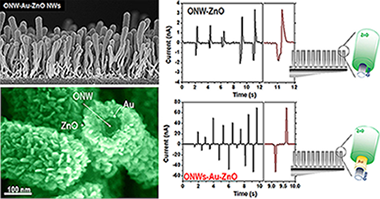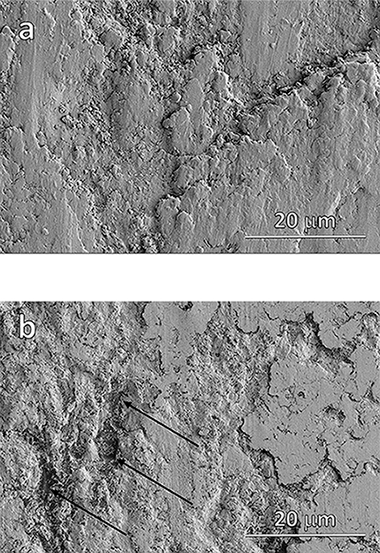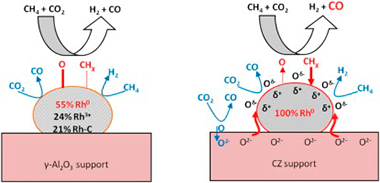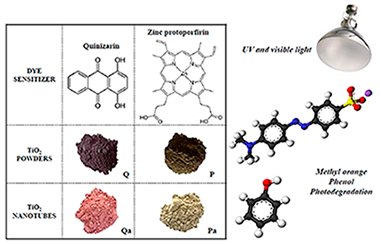Artículos SCI
2019
2019
Nanotecnología en Superficies y Plasma
3D core-multishell piezoelectric nanogenerators
A. Nicolas Filippin; Juan R.Sanchez-Valencia; Xabier Garcia-Casas; Victor Lopez-Flores; Manuel Macias-Montero; Fabian Frutos; Angel Barranco; Ana BorrasNano Energy, 58 (2019) 476-483
Show abstract ▽

The thin film configuration presents obvious practical advantages over the 1D implementation in energy harvesting systems such as easily manufacturing and processing, and long-lasting and stable devices. However, ZnO-based piezoelectric nanogenerators (PENGs) generally rely on the exploitation of single-crystalline nanowires because of their self-orientation in the c-axis direction and ability to accommodate long deformations resulting in high piezoelectric performance. Herein, we show an innovative approach to produce PENGs by combining polycrystalline ZnO layers fabricated at room temperature by plasma-assisted deposition with supported small-molecule organic nanowires (ONWs) acting as 1D scaffolds. Such hybrid nanostructures present convoluted core-shell morphology, formed by a single-crystalline organic nanowire conformally surrounded by a poly-crystalline ZnO shell and combine the organic core mechanical properties with the ZnO layer piezoelectric response. In a step forward towards the integration of multiple functions within a single wire, we have also developed ONW-Au-ZnO nanoarchitectures including a gold shell acting as inner electrode achieving output piezo-voltages up to 170 mV. The synergistic combination of functionalities in the ONW-Au-ZnO devices promotes an enhanced performance generating piezo-currents one order of magnitude larger than the ONW-ZnO nanowires and superior to the thin film nanogenerators for equivalent and higher thicknesses.
Abril, 2019 | DOI: 10.1016/j.nanoen.2019.01.047
Reactividad de Sólidos
Tribological behavior of graphene nanoplatelet reinforced 3YTZP composites
Gutierrez-Mora, F; Morales-Rodriguez, A; Gallardo-Lopez, A; Poyato, RJournal of the European Ceramic Society, 39 (2019) 1381-1388
Show abstract ▽

The tribological behavior of graphene nanoplatelet (GNP) reinforced 3 mol% yttria tetragonal zirconia polycrystals (3YTZP) composites with different GNP content (2.5, 5 and 10 vol%) was analyzed and discussed. Their dry sliding behavior was studied using a ball-on-disk geometry with zirconia balls as counterparts, using loads between 2 and 20 N at ambient conditions and compared to the behavior of a monolithic 3YTZP ceramic used as a reference material. The composites showed lower friction coefficients and higher wear resistance than the monolithic 3YTZP. An outstanding performance was achieved at 10 N, where the friction coefficient decreased from 0.6 to 0.3 and the wear rates decreased 3 orders of magnitude in comparison with the monolithic ceramic. A layer adhered to the worn surface was found for all the composites, but it did not acted as a lubricating film. The composites with the lowest GNP content showed an overall improved tribological behavior.
Abril, 2019 | DOI: 10.1016/j.jeurceramsoc.2018.11.005
Materiales de Diseño para la Energía y Medioambiente
Low molecular weight epsilon-caprolactone-p-coumaric acid copolymers as potential biomaterials for skin regeneration applications
Contardi, M; Alfaro-Pulido, A; Picone, P; Guzman-Puyol, S; Goldoni, L; Benitez, J; Heredia, A; Barthel, MJ; Ceseracciu, L; Cusimano, G; Brancato, OR; Di Carlo, M; Athanassiou, A; Heredia-Guerrero, JAPLoS One, 14 (2019) e0214956
Show abstract ▽
epsilon-caprolactone-p-coumaric acid copolymers at different mole ratios (epsilon-caprolactone: p-coumaric acid 1:0, 10:1, 8:1, 6:1, 4:1, and 2:1) were synthesized by melt-polycondensation and using 4-dodecylbenzene sulfonic acid as catalyst. Chemical analysis by NMR and GPC showed that copolyesters were formed with decreasing molecular weight as p-coumaric acid content was increased. Physical characteristics, such as thermal and mechanical properties, as well as water uptake and water permeability, depended on the mole fraction of p-coumaric acid. The p-coumarate repetitive units increased the antioxidant capacity of the copolymers, showing antibacterial activity against the common pathogen Escherichia coli. In addition, all the synthesized copolyesters, except the one with the highest concentration of the phenolic acid, were cytocompatible and hemocompatible, thus becoming potentially useful for skin regeneration applications.
Abril, 2019 | DOI: 10.1371/journal.pone.0214956
Materiales y Procesos Catalíticos de Interés Ambiental y Energético
Effect of support oxygen storage capacity on the catalytic performance of Rh nanoparticles for CO2 reforming of methane
Yentekakis, IV; Goula, G; Hatzisymeon, M; Betsi-Argyropoulou, I; Botzolaki, G; Kousi, K; Kondarides, DI; Taylor, MJ; Parlett, CMA; Osatiashtiani, A; Kyriakou, G; Holgado, JP; Lambert, RMApplied Catalysis B-Environmental, 243 (2019) 490-501
Show abstract ▽

The effects of the metal oxide support on the activity, selectivity, resistance to carbon deposition and high temperature oxidative aging on the Rh-catalyzed dry reforming of methane (DRM) were investigated. Three Rh catalysts supported on oxides characterized by very different oxygen storage capacities and labilities (gamma-Al2O3, alumina-ceria-zirconia (ACZ) and ceria-zirconia (CZ)) were studied in the temperature interval 400-750 degrees C under both integral and differential reaction conditions. ACZ and CZ promoted CO2 conversion, yielding CO enriched synthesis gas. Detailed characterization of these materials, including state of the art XPS measurements obtained via sample transfer between reaction cell and spectrometer chamber, provided clear insight into the factors that determine catalytic performance. The principal Rh species detected by post reaction XPS was Rh, its relative content decreasing in the order Rh/CZ(100%) > Rh/ACZ(72%) > Fth/gamma Al2O3(55%). The catalytic activity followed the same order, demonstrating unambiguously that Rh is indeed the key active site. Moreover, the presence of CZ in the support served to maintain Rh in the metallic state and minimize carbon deposition under reaction conditions. Carbon deposition, low in all cases, increased in the order Rh/CZ < Rh/ACZ < Rh/gamma-Al2O3 consistent with a bi-functional reaction mechanism whereby backspillover of labile lattice O2- contributes to carbon oxidation, stabilization of Rh and modification of its surface chemistry; the resulting O vacancies in the support providing centers for dissociative adsorption of CO2. The lower apparent activation energy observed with CZ-containing samples suggests that CZ is a promising support component for use in low temperature DRM.
Abril, 2019 | DOI: 10.1016/j.apcatb.2018.10.048
Química de Superficies y Catálisis
Powder and Nanotubes Titania Modified by Dye Sensitization as Photocatalysts for the Organic Pollutants Elimination
Murcia, JJ; Avila-Martinez, EG; Rojas, H; Cubillos, J; Ivanova, S; Penkova, A; Laguna, OHNanomaterials, 9 (2019) 517
Show abstract ▽

In this study, titanium dioxide powder obtained by the sol-gel method and TiO2 nanotubes, were prepared. In order to increase the TiO2 photoactivity, the powders and nanotubes obtained were modified by dye sensitization treatment during the oxide synthesis. The sensitizers applied were Quinizarin (Q) and Zinc protoporphyrin (P). The materials synthesized were extensively characterized and it was found that the dye sensitization treatment leads to modify the optical and surface properties of Titania. It was also found that the effectiveness of the dye-sensitized catalysts in the phenol and methyl orange (MO) photodegradation strongly depends on the dye sensitizer employed. Thus, the highest degradation rate for MO was obtained over the conventional Q-TiO2 photocatalyst. In the case of the nanotubes series, the most effective photocatalyst in the MO degradation was based on TiO2-nanotubes sensitized with the dye protoporfirin (ZnP). Selected catalysts were also tested in the phenol and MO photodegradation under visible light and it was observed that these samples are also active under this radiation.
Abril, 2019 | DOI: 10.3390/nano9040517
- ‹ anterior
- 135 of 420
- siguiente ›














